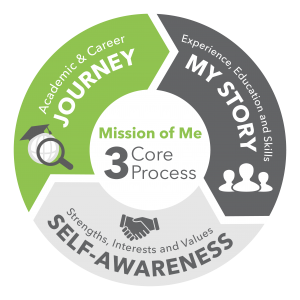
Client Side: What I learned from quitting my job to study cannabis in my 30s
October 7, 2019
How will climate change affect the future of employment in Canada?
October 7, 2019Ed Hidalgo
With a goal of bringing greater clarity and consistency to our national conversations about career development, CERIC developed a set of “Guiding Principles of Career Development” that have been enthusiastically embraced across Canada. These eight Guiding Principles are intended as a starting point to inform discussions with clients, employers, funders, policymakers and families. Each issue of Careering features a Guiding Principle “in action,” exploring how a career professional is applying a Principle in practice.
Guiding Principle: Career development can be complex and complicated, so context is key – there may be both internal constraints (financial, cultural, health) and/or external constraints (labour market, technology).

A model for context in career development
The school district in which I work, located in El Cajon, CA, has 27 schools and 17,500 students. It is one of the most wonderfully diverse districts in the region, with some of the highest numbers of refugee families regionally as well as students from a mix of socio-economic backgrounds.
As Wehrle, Kira and Klehe’s (2018) and Eismann’s (2016) research highlights, first-generation students and refugees experience unique barriers that limit their engagement and advancement into available career paths, diminishing their career choice privilege. Understanding the internal and external constraints students may experience has been core to our mission of providing contextualized career development in our classrooms.
My school district uses a process called “World of Work” to provide every child with career development that is integrated within their classroom curriculum and deployed by teachers.

- Learning about their strengths, interests and values
- Exploring the labour market and learning about jobs and academic opportunities in their community
- Forming their stories based on their increasing self-awareness and exposure to opportunities available to them
The Mission of Me is integrated through four levels of exposure: 1) explore a job, 2) participate in an “as if” experience or simulation, 3) meet a professional who does the job, and 4) participate in a demonstration of learning or practice. Through this process, teachers integrate technology, reading, math and science, and equally important, provide an opportunity to apply knowledge to real-world problems. We encourage students to reflect on their learning and how their Mission of Me connects to the people in the job they explored.
As we work with students to integrate careers education in the early grades, it’s important to communicate that this work is not about encouraging students to select a pathway or make decisions, but rather to create opportunities to explore, meet professionals, and develop context and application for what they are learning. The goal is to expose young people to all types of work environments and career skills and keep them from foreclosing prematurely on possibilities as they work to develop their identity. While career development is complex and complicated, it can also become more accessible to young people when they have a supported space in which they can explore the world of work.

iStock
Creating a common language
We believe that context is key – as the Guiding Principle states – to understand both our students’ needs and how to develop programming to support their career development. This is why we actively engage parents in our programs and why we use the RIASEC as the guiding framework for building a common language of career interests across the school and family.
The RIASEC vocational interest typology developed by Holland (1959, 1997) is “the most widely adopted theoretical framework for interest measurement” (Briley et al., 2017, p. 6). Holland’s typology describes people according to their resemblance to six vocational personalities and environments known as the RIASEC.
Parents are invited to work with World of Work coaches in training aimed at improving student and adult learning related to the world of work. During this three-course experience, families can explore their own strengths, interests and work values, learn the language of the RIASEC, hear about career opportunities and begin to create a common language of careers they can use with their children.
More than 900 families have joined us for some form of career development learning over the past school year. Breaking down institutional and cultural barriers is critical to serving our families and leveraging the power of schools, which are trusted entities in the eyes of parents and a tremendous way to support career development across students’ life span.
Don’t miss our previous Principles in Action articles
Change is inevitable in career development. Fear of it shouldn’t be
Embracing external influences to help guide career exploration
Sammy’s story
Like many students in our district, Sammy began his schooling as an English-language learner and first-generation citizen. When Sammy was in Grade 4, his teacher became an early adopter of integrating career development in her class. Over the school year, Sammy participated in career exposure activities, simulations and meet-a-pro opportunities.
It was during one meet-a-pro experience that his idea about his possible future career options changed. He was introduced to the district superintendent during a school visit. During their conversation, Sammy realized they both identified with the same RIASEC themes. As he learned more about the work of a superintendent, his interest piqued and he even envisioned himself in the role. The superintendent offered Sammy the opportunity for a job shadow. Now in Grade 5, Sammy continues to be interested in the path of superintendent. And, importantly, as he heads into middle school, he’s even more motivated to do well and achieve his goals.
Access for all
Providing career development in the early grades affords educators the opportunity to proactively moderate contextual barriers that can impede students’ success, such as gender, race, learning differences and socio-economic status. Integrating career development with classroom learning ensures access for all students, which in turn benefits the communities where they live by putting them on a path to gainful employment.
Ed Hidalgo is the Chief Innovation and Engagement Officer for the Cajon Valley Union School District in San Diego, CA. Prior to his current role, he was the Director of the World of Work Initiative at the University of San Diego Jacobs Institute for Entrepreneurship in Education. His experience in career development and training comes from nearly 20 years in human resources, staffing and government affairs, most recently at Qualcomm. RIASEC: SEA; MBTI: ESFJ. Follow him on Twitter @EDhidalgoSD.
References
Briley, D., Rounds, J., & Hoff, D., & Wee, C. (2018). Normative changes in interests from adolescence to adulthood: A meta-analysis of longitudinal studies. Psychological Bulletin, 144(4).
Cahill, M., & Furey, E. (2017). The Early Years: Career Development for Young Children: A Guide for Educators. Toronto, ON: CERIC.
Eismann, L. (2016, November 1). First-generation students and job success. NACE. Retrieved from naceweb.org/job-market/special-populations/first-generation-students-and-job-success/
Holland, J. L. (1959). A theory of vocational choice. Journal of Counseling Psychology, 6, 35– 45.
Holland, J. L. (1997). Making vocational choices: A theory of vocational personalities and work environments (3rd ed.). Odessa, FL: Psychological Assessment Resources.
Kashefpakdel, E., Rehill, J., & Hughes, D. (2018). Career-related learning in primary. What works? The Careers & Enterprise Company. Retrieved from careersandenterprise.co.uk/research/career-related-learning-primary-what-works
Wehrle, K., Kira, M., & Klehe, U.-C. (2018). Putting career construction into context: Career adaptability among refugees. Journal of Vocational Behavior, 111, 107–124.

